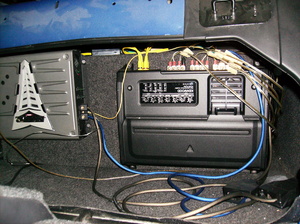The average person spends a substantial amount of time in their vehicle driving to work, running errands or picking up the kids. That adds up to a lot of time, a lot of time often spent listening to the worst sound system they own. Stock audio systems found in automobiles (I’ll refer to them as cars from now on) are typically underpowered, distorted and limited in features.
Thankfully, with some basic knowledge of electricity, a little research, a few tools and some cash, it’s possible to customize your car audio system to match your tastes and sound superior.
Deck
The first and easiest method of improving your sound system is replacing the stereo itself, also known as a deck or head unit. This is the brain of your sound system and currently, along with the speakers, antenna and wiring, makes up your stereo system. Most factory decks are woefully underpowered and sound crummy at best. You can visit a car audio specialist to get input, but you probably can pick out a head unit that’ll sound better yourself.
First, figure out what features you want. Do you want a built-in iPod connector? Do you want to connect to Sirius/XM? What about adding a sub woofer down the line? You’ll want to narrow your search down to decks that are capable of handling your needs. Second, check out some of the specs. Power is measured in watts, but only the RMS rating – typically about 75 of the total power and what your system will pump out when it’s not peaking – is important. Also keep an eye on the Total Harmonic Distortion (THD) rating, the lower the better. Third, check out the brands. It’s far better to get a lower level Alpine or Pioneer head unit than a more powerful Jensen. Fourth, see if it’ll fit. Ever since the invention of audio CD players, head units have been measured in DIN. Either check with your local car audio specialist or punch your car into Crutchfield to find out what size you have and what’ll fit. Finally, consider the price. Sure, you can find a stereo with a million options, no distortion and lots of power, but can you afford it. Overall good decks can usually be found for $100-200.
To install the deck, ask your local car audio specialist or find a friend who’s done it before. You might also want to research your car and stereo online for additional help. Some vehicles, like Mercury Villagers, are easy to replace decks while others, like the Ford Taurus, is a real pain. Don’t go it alone, get some help for this job.
Speakers
This is more of an add-on to the last topic, but replacing the stock speakers in your car is critical to building a solid sound system. Adding great speakers to a stock deck will do nothing, and leaving old stock speakers in with a new head unit may cause damage if they can’t handle the power. Either way, it’s imperative to replace the speakers in your cabin.
The first step is to figure out how many and what size speakers are in the car. Again, Crutchfield is wonderful for this, although your local expert should be able to help. The next step entails reviewing your deck and other system specifications. Speakers are also measured in power, the amount they can handle. Make sure that the speakers you select will never be subject to more power than they can handle. The third step is to chose between component and coaxial speakers. The former are actually separate speakers – tweeter for highs, midbass for middle and sub woofer for lows, sound better, are more work to be installed and cost a lot more. Coaxial speakers include everything in one package at a lower price, but don’t sound as good. You’ll probably be find with coaxial speakers, especially if this is your first audio upgrade. Finally, go to a store and listen to several speakers you like. Sure, you can buy them online or from a catalog, but why miss the opportunity to find out the set that looked good on paper actually sounds awful?
Like the head unit, you definitely want to seek help with installing these speakers. This job differs greatly by the vehicle. Replacing the front two speakers typically requires removing the inside portion of the door, often by undoing many screws and snaps. Working on the back speakers can mean removing more doors, working in the trunk or removing other parts of the interior behind the head rests. Once you have access to the speakers, unscrew them and remove the wiring close to the speaker – do not cut it at the door because you’ll need all the length you can get. Then, either solder the wires to the terminals with the right polarity or crimp the wires with connectors and attach. Connect your new speaker to the door frame and reassemble the door.
Sub woofers
Sub woofers are the bad boy to car audio systems. These are what will get you a bad reputation in the neighborhood for being the jerk who drives by with the bass cranked to 11. I’ve been told that, as a general rule, if you want to shake cars down the street, you’ll need at least 1,000 watts of sub woofer power.
That said, when used responsibly, sub woofers are an integral part of better systems. Sub woofers are actually just speakers that are designed to reproduce only bass. Many decks are weak on bass and the sound coming from the cabin speakers tends to be high on treble and midrange. A solid amount of sub woofer power can actually add more depth to the sound, and give the car its classic vibrations.
Sub woofers are circular and come in a variety of sizes, including 8″, 10″ and 12″. Larger sizes handle lower frequencies, but smaller sizes sound more crisp. Selection comes down to the style of music you play and your preference. Next, figure out how much sub woofer power you need/want. Like all speakers, sub woofers can only handle so much power. Keep in mind that you can always install multiple sub woofers instead of a gigantic one. Once you’ve narrowed down the field, gently touch the sub woofer. The main portion of a speaker is called the cone and you want to avoid a paper cone if possible. The part connecting the cone to the basket of the speaker is called the surround, and rubber surrounds will help the sub woofer last longer. And finally, consider brands and prices. A better quality sub woofer will sound better than a larger, cheaper one.
Sub woofers also need to be installed, but unlike regular speakers, can be put just about anywhere. The most common way to install sub woofers is in a box. Tell your local car audio specialist about your subs and have them help you choose a box. You can also build one out of plywood or medium density fiberboard, but that includes lots of math and carpentry skills. Instructions and calculators are readily available online.
Amplifier
You’ve got the sub woofers mounted in a box in your car, but they’re just sitting there and not pumping out bass. That’s because they’re passive speakers, and require some type of signal. Theoretically, you may be able to hook it up to your head unit, but it’s not designed for that and won’t have enough power. Producing bass requires a lot of power. The answer is installing an amplifier. Connected in between the deck and speakers, amplifiers increase the power of the audio signal. Many systems use them for cabin speakers, but they are critical for sub woofers.
Before you do anything else, figure out how many speakers you want to connect. Each connection is called a channel, and channels are a major factor in amplifier prices. Keep in mind that you may be able to connect two sub woofers to one channel and gain extra power by wiring them in parallel and reducing the resistance; make sure the amplifier is stable at lower ohms if you plan on doing that. The next step is determining the necessary power, how much do you need. Again, take a look back at all of your speakers and sub woofers, add the RMS wattage and start looking for an amplifier(s) that won’t overdrive them. THD is even more critical with power amplifiers than head units, as the signal will get much more amplified here. Finally, take a look at brand and price. Quality again is absolutely essential here and a solid amp from a well-known company will sound far superior to a more powerful amp from a shady manufacturer.
Installing an amplifier requires running thick power cables through the car, attaching at least one fuse along the way, permanently mounting the amplifier itself somewhere it won’t overheat, connect the smaller trigger cable to the car’s power antenna feed and connecting the speaker cable. This is a job for an expert and is not recommended for newcomers to the field. If you use a fuse rated too high, the vehicle could catch fire. On the other hand, if you cram the amplifier in a corner and block the airflow, it’ll regularly shut down to prevent overheating.
Other
Those are just the four main pieces of the average car stereo and alone can make a world of difference. Along the way, you may need or want additional equipment. For example, a capacitor can hold extra electricity and release it when necessary if your amplifiers are drawing too much current from the alternator. Worried about which sounds come out of which speakers? Buy a cross-over. There’s a lot of extra pieces you can add, but it’s worth having a chat with your local car audio expert.





